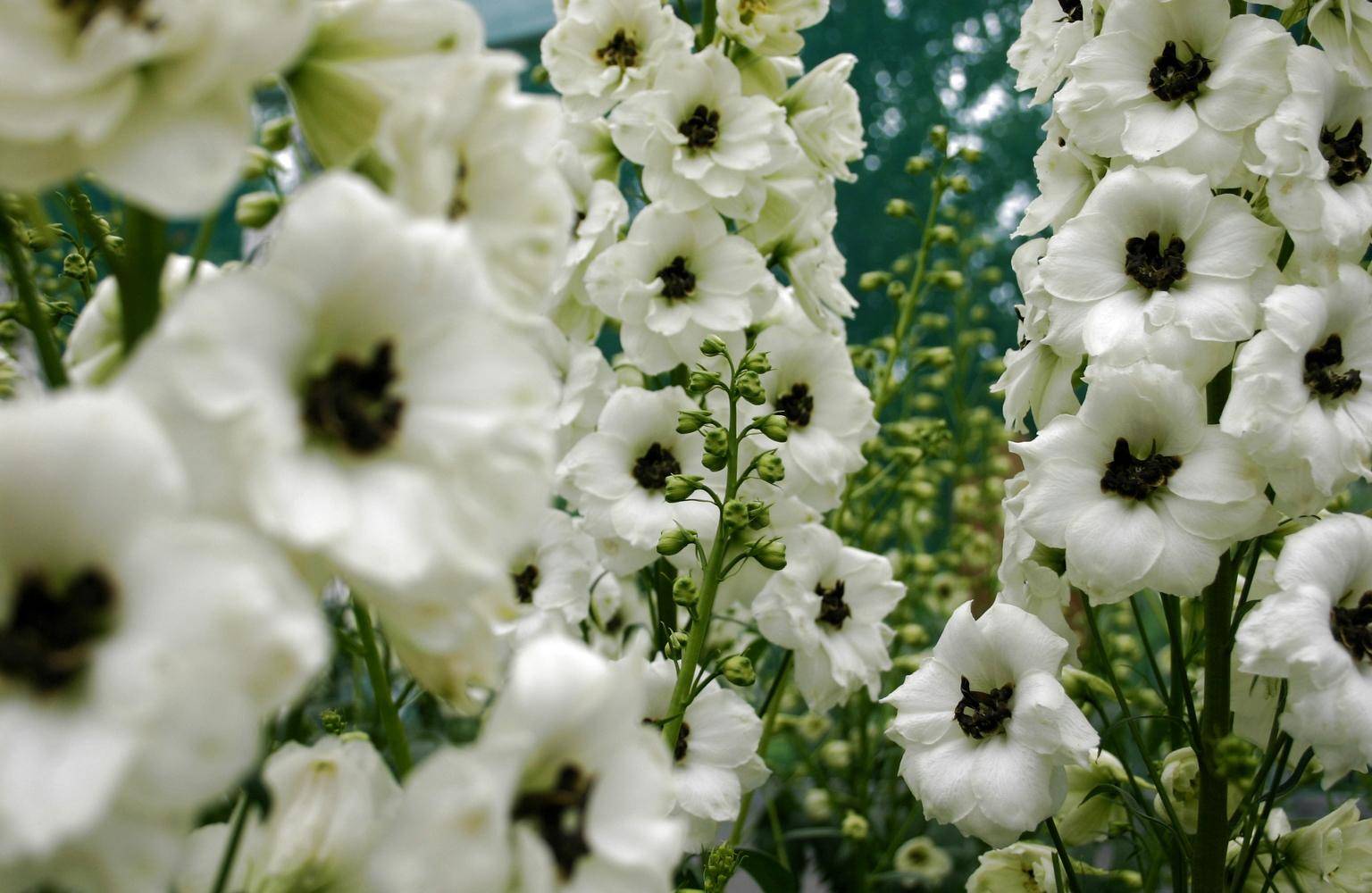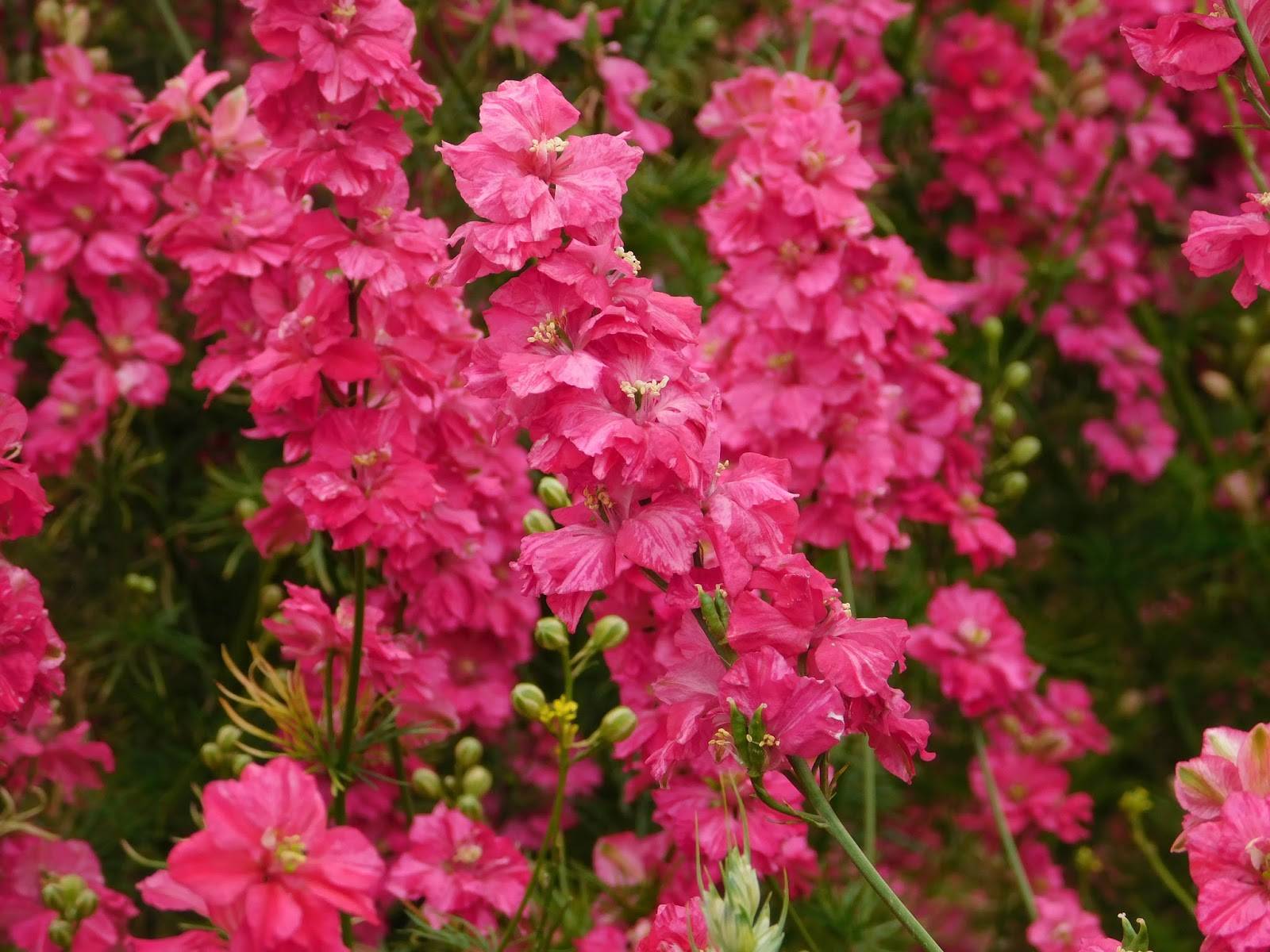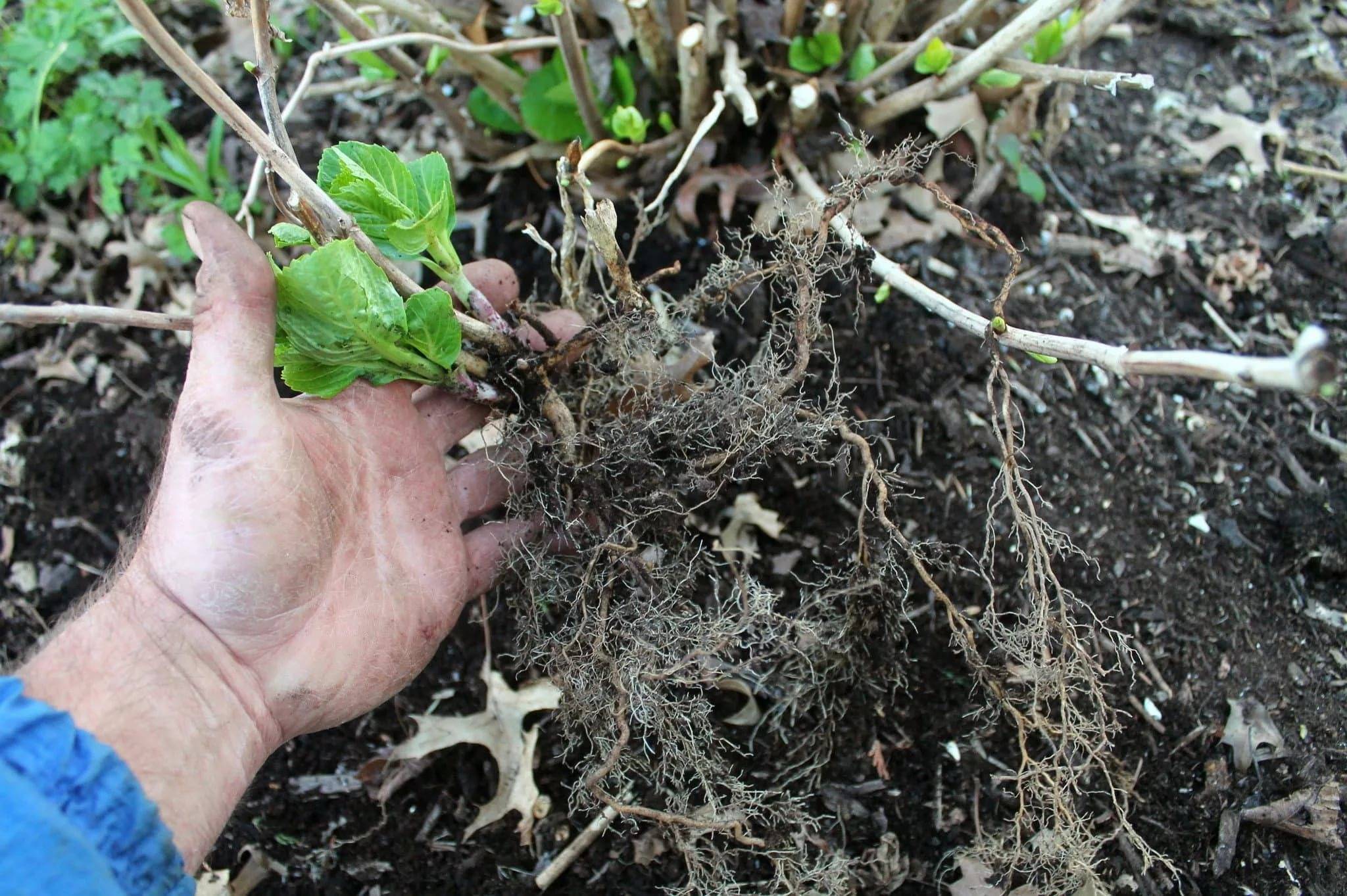Delphinium perennial
Content:
Perennial Delphinium is a beautiful garden planting that gives a cozy look to any flower garden. This plant has been known to mankind for a long time. It is quite unpretentious to care for, grows well in the open field. Among other inhabitants of the flower garden, it will stand out for its height, splendor of inflorescences and harmony. No one dares to compete with its monumentality and solidity.
The origin and appearance of the delphinium plant
The delphinium flower is also called "larkspur" or "spur". The name itself comes from the Latin word "delfinion" and seems to hint that the inflorescences are similar to the nose of a dolphin. The plant belongs to the Buttercup family; Europe, China, Siberia, Mongolia are considered its homeland. And this suggests that it can bloom in any climatic conditions.
In natural habitat, the flower usually "settles" on the plains, meadows, forest glades or outskirts, the banks of streams.
Description of the delphinium flower
In the description of the planting, it is indicated that its height varies from 0.8 to 2 meters. The stems do not branch, they are tough and erect. A rosette is formed from the leaves, and they are rather large in size, finger-pinnate, serrated. Most often they are located opposite each other. The roots of the flower are thick and fibrous.
The flowers of the plant form inflorescences, reaching a height of 0.8-0.9 meters. They are located on the tops of the stems in long clusters. Their color range is different - the petals can be both white and purple, lilac. They are simple or terry in shape. Flowers attract bees, bumblebees, as they are among the honeybees. Flowering time is usually from mid-June to July.
Types and varieties of delphinium
There are more than 1000 varieties of delphiniums known in the world. The most common are those delphiniums, care and cultivation of which are not difficult. All of them grow in different countries, differ significantly in appearance, which can be shown in a greenhouse. In the latitudes of Russia, two species grow independently in their natural environment, while the rest are grown at home.
There are three common plant varieties:
- tall, New Zealand - capable of growing up to 3 meters in height, the stems are hairy, the leaves are similar in shape to human fingers;
- large-flowered, undersized - reaches 0.8 m in height, differs in a downy stem, inflorescences form lush brushes;
- field, Marfinsky - is characterized by increased resistance to frosty weather, reaches a height of 1.2 m to 1.6 m, belongs to annual plants.
For the first time, they started talking about breeding delphinium at the beginning of the 19th century. Even then, the species began to cross among themselves to develop new varieties.
Delphinium white
Delphinium white is represented by the following hybrids:
- Galahad;
- Meriaym;
- Morning Sunrise;
- Green Twist;
- Spring Snow;
- Daughter of Winter;
- Casablanca.
The presented varieties usually reach a height of 1.5 meters. They are distinguished by large inflorescences, magnificently blooming. Some of the forms are dwarf, which means that their height will be no more than 0.8 meters.
Delphinium yellow
Most often, representatives of the yellow delphinium are:
- semi-bearded delphinium, namely the Sunny Knight variety;
- New Zealand delphinium, Cream variety;
- delphinium English, cultivar Sungleam.
The height of the plantations reaches 1.2 meters. Plants with yellow flowers are thermophilic. They thrive in hot climates, bloom best of all, being constantly in direct sunlight.
Delphinium blue
Given the number of hybrid forms of the plant, it is easier to sort it by shade. So, delphinium blue is found in varieties such as:
- Black Knight;
- Morning Lights;
- Pacific;
- Berghimmel;
- Blue berry Pie;
- Sweet Sensation.
Flowers are distinguished by their richness of shades, beautiful tints.
Delphinium blue
Delphinium of a blue shade is represented by such varieties as:
- Capri;
- Camellard;
- Magic fountain;
- Crystal Delight;
- Arnold Becklin;
- Blue lace;
- Caravan;
- Volkerfried;
- Blue Jay;
- Blue Bird;
- Sunny Skies;
- Moon Light.
Delphinium terry
The brightest representatives of the terry delphinium are such varieties as:
- Blue Lace;
- Ajax;
- Astolat;
- King Arthur;
- Morpheus;
- Black Knight;
- Ginever;
- Highlander Blueberry Pie;
- Royal Aspirations;
- Misty Mouves.
The described varieties are distinguished by lush inflorescences that attract the attention of others.
Delphinium pink
The most beautiful hybrids of pink delphinium are:
- Red giant;
- Princess Caroline;
- The pledge of youth;
- Summer morning;
- Deep Sweethearts;
- Dusky Maiden.
Inflorescences can be of different shades - from rich red-pink to pale and delicate. It is often said that they look like real butterflies.
Delphinium transplant after purchase in open ground
Growing a delphinium in a garden is possible subject to the conditions necessary for this. When properly cared for, a plantation can boast lush blooms and impressive, tactile leaves. When buying a plant, it is important to follow the rules for transferring it from a pot to open ground.
What is needed for landing
There is an opinion that perennial delphiniums, planting and caring for which do not require special conditions, should still be studied before breeding in a garden. It is worth preparing for planting a plant. The stages of preparation will be:
- choice of location;
- purchase of seeds or ready-made seedlings;
- purchase of equipment, if necessary (shovels, special gloves, devices for loosening the soil, fertilizers).
After the preliminary stages have been passed, and the soil is prepared, you can proceed directly to planting.
Choosing the best place
The place where the flower can be planted should be sunny and sheltered from the wind. If you place a tall plant in a blown area of a flower garden, you can sooner or later observe broken stems. After this, it will not work to return the plantings to life; you will have to acquire new seedlings.
If the shadow period during the day is more than sunny, you should not count on lush bloom. The flowers will most likely not be as bright and impressive.
The soil in the area for planting should be fertile, humus, moderately moist and permeable. It is a known fact that "spurs" can grow on clay soil. When it comes to sandy soil, it is necessary to prepare it in advance, to increase fertility and the ability to absorb water.
Step-by-step planting process
Delphinium planting takes place in several stages. It is important to observe them so that the plant looks great as it grows:
- Clear the area before planting from weeds.
- Soak the seeds of the plant in a fungicide solution or a weak manganese solution for half an hour.
- Rinse the seeds that have passed the disinfection procedure with running water, dip them into the stimulant mixture.
- Dry the seed.
- Sow seeds into the ground in boxes, taking care of their measured distribution.
- Sprinkle them with a spray bottle.
- Cover the seeds with foil, place them on the windowsill closer to the window glass.
- Moisten the soil from time to time.
- Plant the seedlings in the ground as soon as 2-3 stalks appear on the sprouts.
When planting sprouts, it is worth remembering that the distance between them should be at least 35-50 centimeters. To normalize the soil, greenhouse soil or its mixture with compost is placed in the replanting pits. This will help protect the plant from diseases, make it more resistant to the harmful effects of external factors. It is recommended to cover seedlings with transparent jars at first. After a couple of days, they are removed for good.
Reproduction of delphinium
Delphinium can reproduce in several ways. Growing from seed is most commonly used in greenhouses and home gardens, but other methods are also used.
Cuttings
When propagating a delphinium by cuttings, it is important to follow a certain procedure:
- cut off apical cuttings at least 10 cm long in early spring;
- root cuttings in peat and sandy soil, mixed in equal proportions;
- plant the cuttings in the ground to a depth of 2 cm, cover them with plastic cans;
- keep the soil moist, make sure that the temperature under the jars is at least 20 ° C.
Rooting cuttings is a long process. You can open them after the plant has taken root. Before planting them on permanent soil, at least a year should pass. Otherwise, the plants will die. The distance when planting plantings should be at least 30 centimeters.
From seed
Seeds can be bought from breeders, flower growers, or you can collect them yourself. Seeds are collected in several ways:
- sprinkle seeds from cracked bolls that are on the lower parts of the stem;
- the tops are cut and wrapped in a bag, and then placed with the crown down;
- the stems are cut and hung in a dry place for ripening if weather conditions have not allowed them to mature naturally.
It is recommended to store seeds in the refrigerator door at a temperature not exceeding 5 ° С.
By dividing the bush
The presented method of reproduction excludes the loss of planting material.
The division process takes place in several stages:
- a perennial is dug out of the ground, with a sharp tool its rhizome is cut;
- all old shoots and leaves are removed;
- the parts obtained during division are seated on the site, it is advisable to leave the kidneys on them.
This method of flower propagation is recommended for use in early spring or autumn.
Delphinium care
Delphiniums, in fact, do not require special care and cultivation. Compliance with the necessary conditions will allow the flower to delight the owners with lush inflorescences and beautiful leaves.
Watering mode
To make the leaves of the delphinium bright green, juicy, it is recommended to make additional watering of the plant if there is no rain for a long time. Young sprouts are watered regularly, regardless of rainfall.
Top dressing
"Shpornik" loves when florists carry out the soil mulching procedure.If the preference was given to organic fertilizers, mineral fertilizers are not used, and vice versa.
During the first flowering period, feeding is not carried out, but after it it is advisable to enrich the soil with compost fertilizer, cut off the tops of flowers by 10 centimeters. It is thanks to this that the abundant flowering of the plant in the middle of summer is guaranteed.
Features of care during the flowering period
During flowering, it is necessary to loosen the soil around the plants. It is also important that the inflorescences do not get water during watering. There are 2 to 3 buckets of water per bush, regardless of whether it rained or not.
Features of care during the rest period
After the plant has bloomed, the stems are cut off. In the spring, beautifully growing plantations are formed by removing branches that spoil the appearance.
Preparing for winter
Flowers do not need additional care in the winter. This is especially true for varieties that delight the eye of flower growers for several years.
However, if you had to plant new plants in the spring, it is recommended to cover them with a plate with protective properties for the winter. Mature flowers are cut off, while young ones no longer show and are covered with soil until spring.
Dealing with a delphinium is easy. This flower is ideal for those looking to decorate their garden with beautiful plantings in a short time. To sow it, you do not need special skills and abilities. Proper care and cultivation of the plant will allow you to enjoy beautiful flowers for a long time.













